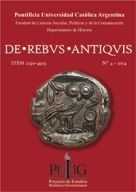Please use this identifier to cite or link to this item:
https://repositorio.uca.edu.ar/handle/123456789/7156| Título: | La distruzione delle statue di Pausania nella Sparta tardoantica (Lib. Ep. 1518) | Autor: | Raimondi, Milena | Palabras clave: | HISTORIA ANTIGUA; HISTORIA DE GRECIA; PAGANOS; CRISTIANOS; CONFLICTOS RELIGIOSOS; CONFLICTOS POLITICOS | Fecha de publicación: | 2014 | Editorial: | Pontificia Universidad Católica Argentina. Facultad de Ciencias Sociales, Políticas y de la Comunicación. Departamento de Historia | Cita: | Raimondi, M. La distruzione delle statue di Pausania nella Sparta tardoantica (Lib. Ep. 1518) [en línea]. De Rebus Antiquis. 2014, 4 Disponible en: https://repositorio.uca.edu.ar/handle/123456789/7156 | Resumen: | Abstract: The late antique destruction of two bronze statues of Pausanias - the Spartan general responsible for the Greek victory at the Battle of Plataea (479 BC) - housed in the temple of Athena Chalkioikos in Sparta (Lib. Ep. 1518), has been interpreted as one of the few cases of a violent conflict between pagan and Christian population in Greece. Nevertheless the sources suggest that late antique Sparta was a bastion of Hellenic paganism and give a picture of a small and quiet town ruled by a pagan educated élite, where pagans like Libanius wanted to live. Since there is no evidence of a violent conflict between pagans and Christians in Sparta, and Libanius confirms that in 365 AD all the temples and cult statues were still in place, this paper addresses the issue from a different point of view and offers a new contribution to the history of Sparta in Late Antiquity. By using literary, archaeological and epigraphic evidence the paper explores: 1) the relationship between Roman administration and Spartan élite in the IVth century AD; 2) the historical memory of Pausanias in Late Antiquity. It will be emphasized that the obscure burning of the two statues helped to remove from Sparta the memory of Pausanias - a controversial figure, misrepresented in Late Antiquity and connected to the ancient staseis in Laconia - in order to promote a positive image of Sparta as a city without conflicts and ruled by the political system of Lycurgus (eunomia). As documented by local inscriptions in praise of late Roman governors, the mythical lawgiver Lycurgus was the paradigm of the imperial governors who rebuilded the town in the IVth cent. AD. It can be assumed that while Rome, Constantinople, Antioch and Athens were troubled by political and religious violence or by seditions between different factions, Sparta aimed to revive its traditional model of civic order in the new historical context of Late Antiquity. Riassunto: L’articolo offre un nuovo contributo alla storia di Sparta tardoantica a partire da una riconsiderazione dell’oscura distruzione tardoantica delle statue di Pausania, il vincitore di Platea, testimoniata da una lettera di Libanio (Ep. 1518), in genere interpretata nel contesto del conflitto tra pagani e cristiani e dell’iconoclasmo cristiano delle statue pagane. In assenza di una documentazione sull’esistenza di un conflitto tra cristiani e pagani nella Sparta del IV sec. d. C., si cerca di inquadrare la vicenda nel quadro delle relazioni tra la città e l’amministrazione imperiale nel IV secolo e della memoria storica della figura di Pausania. La riproposizione della figura di Licurgo come modello dell’operato dei governatori tardoantichi impegnati nella ricostruzione della città e la celebrazione del sistema licurgico fondato sulla eunomia e sulla risoluzione delle staseis dell’antica Sparta rendeva alquanto inattuale la figura di Pausania, un personaggio nella tarda antichità rappresentato come dannoso ai Greci e associato alla memoria delle antiche staseis a Sparta. Nel quadro di un revival tardoantico di Sparta, la distruzione delle statue di Pausania contribuì alla idealizzazione, promossa dall’élite locale, di Sparta come città saggia, ordinata e senza staseis che faceva della città laconica un modello ben diverso da quello offerto da importanti città tardoantiche quali Costantinopoli, Roma, Antiochia o anche Atene, notoriamente caratterizzate da staseis, scontri tra fazioni, violenza e conflitti politici e religiosi. |
Cobertura Espacial: | ESPARTA | URI: | https://repositorio.uca.edu.ar/handle/123456789/7156 | ISSN: | 2250-4923 | Disciplina: | HISTORIA | Derechos: | Acceso Abierto | Fuente: | De Rebus Antiquis. 2014, 4 |
| Appears in Collections: | DRA - 2014 nro. 4 |
Files in This Item:
| File | Description | Size | Format | |
|---|---|---|---|---|
| distruzione-statue-pausania-nella-sparta.pdf | 384,92 kB | Adobe PDF |  View/Open |
Page view(s)
111
checked on Apr 30, 2024
Download(s)
351
checked on Apr 30, 2024
Google ScholarTM
Check
This item is licensed under a Creative Commons License

